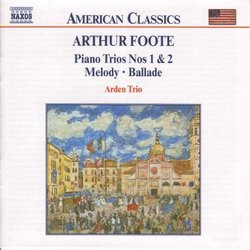| All Artists: Arthur Foote, Arden Trio Title: Foote: Chamber Music, Vol. 3 Members Wishing: 0 Total Copies: 0 Label: Naxos American Release Date: 7/18/2000 Genre: Classical Styles: Chamber Music, Historical Periods, Classical (c.1770-1830), Instruments, Strings Number of Discs: 1 SwapaCD Credits: 1 UPC: 636943903926 |
Search - Arthur Foote, Arden Trio :: Foote: Chamber Music, Vol. 3
 | Arthur Foote, Arden Trio Foote: Chamber Music, Vol. 3 Genre: Classical
|
Larger Image |
CD Details |
CD ReviewsArthur Foote - quickly becoming a chamber music favorite! Sean Patterson | Westerville, Ohio United States | 12/12/2003 (5 out of 5 stars) "Once again, I am indebted to Naxos for unearthing more great American composers than you can shake seven dollars at. Never before Naxos had I heard of Arthur Foote and I am greatful for the three CD's so far released of his chamber music. Not only am I a huge fan of Romantic era music, but of chamber music as well. This third release of his chamber music does not disappoint. The two Piano Trios and the two works for piano & violin are clearly the inspiration of other Romantic giants, such as Dvorak, Brahms, and Schumann. But as the reviewer for ClassicsToday.com stated, Foote is no wannabe. He most assuredly has his own voice and knows the difference between plagarism and being inspired by another composer. If you are looking for excellent late Romantic chamber works, you can't go wrong with any of Arthur Foote's music. Enjoy!" New England Romanticism in its best sense Sean Patterson | 02/17/2001 (5 out of 5 stars) "I am a senior at Arthur Foote's alma mater (Harvard) and I find that his music wonderfully captures the spirit of New England in its simplicity, directness, and tunefulness. These works are extremely well performed--the pianist is very sensitive, particularly to the beautifully undulating lines of the first trio in c minor. The second trio is much more sharply "New England" in style, with its somewhat angular melodies and crisp rhythms. Reminds me of a spring day in the Boston Public Garden. How can the old Yankee temperment not appear in Foote? He was a native of Salem, MA, the descendant of sea captains, and the son of the publisher of the Salem paper.Foote's style is indebted to European models, yet I firmly believe that its character is pure 19th century Boston. If you are looking for the music of the era and cultural climate of Henry Adams, Isabella Stewart Gardner, and Charles Eliot, then this is your music. The most appropriate visual complement to this music is Commonwealth Avenue in Boston's Back Bay-- an impeccabbly preserved area lined with 1870's and 1880's Victorian brownstones and mansions and shaded by large trees in the center of the boulevard. While this music hardly blazes new trails, it stands very well on its own and well-represents the "Athens of America" that Boston has always striven for. Clearly, Boston was much more conservative in its musical tastes than New York City, and would ultimately lose its strong musical influence. However, Foote represents the best of the Boston Classicists, and is well worth exploring for its historical and cultural merits as well as its musical ones.Also, the price is right." Beautiful, intimate, pieces. Excellent performances. Jeffrey Lehman | Market Harborough, UK | 02/26/2002 (5 out of 5 stars) "I have all 3 volumes of Arthur Foote's chamber music on Naxos, and consider all three to be wonderful, but this disc is the best of the three.
Foote's music was not groundbreaking, radical or new, but what he did, he did well. The result, classical music that will delight people who want a classical music experience, but might leave a few cold-hearted modernists bored. For the rest of us, from start to finish this is a delightful disc. The performances are imeccable, and the recording is clear. At the bargain price it is an absolute steal." |

 Track Listings (9) - Disc #1
Track Listings (9) - Disc #1